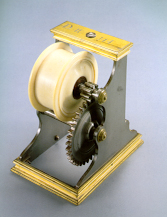
17.8 x 16.5 x 11.8
Steel, brass and ivory
INDEX 1788 : D.II.144
Machina ex rota dentata, ac Timpano eburneo composita.
Machine consisting of a cogwheel and an ivory drum.
This equipment, built according to the model described by 's Gravesande in his Physices Elementa, allows one force to be balanced by another 50 times smaller.
The upper axle of the mechanism consists of a moveable ivory drum, 10 cm in diameter, and a cogwheel with seven teeth. The lower axle, 1 cm in diameter, has another cogwheel, with 35 teeth, which engages the first wheel.
One end of a cord is caught in a ring fixed in a groove of the drum; the cord is then wound round the drum, and a weight is hung from the free end. Another cord is then caught in another ring on the lower axle and wound round it, and a body is suspended from the free end. In order for the two forces to balance each other, the weight of the body has to be equal to 50 times (10 x 5) the force needed to balance it, since the diameter of the lower axle is 10 times less than that of the drum, and the larger cogwheel revolves five times for each turn of the smaller one.
The mechanism should stand on a table which has an opening in its top so that the hanging weights can descend freely.
From Colégio dos Nobres, catalogue n.º 135.
Carvalho, Rómulo de, História do Gabinete de Física da Universidade de Coimbra, Universidade de Coimbra, Biblioteca Geral, Coimbra, 1978, pp. 285-287.
's Gravesande, Willem Jacob, Physices Elementa, Leiden, 1742, § 299, Tab. XI, Fig. 3.